| Article ID | Journal | Published Year | Pages | File Type |
|---|---|---|---|---|
| 5923707 | Physiology & Behavior | 2015 | 6 Pages |
â¢Ratios of fluid to food intake increased within the course of the meal.â¢Fluid and food intakes decreased progressively with meal advancement.â¢Caloric beverages led to similar fluid intake compared to water during the meal.â¢Caloric beverages added to mealtime cumulative energy intake throughout the meal.â¢Baseline thirst correlated with both fluid and food intakes at the meal.
The objective of this study was to describe the interaction of beverage and food intake with meal advancement in healthy adults. In a randomized controlled study, 29 men and women consumed to satiation, over 20 min, a pizza meal with one of the five beverages including water, 1% milk, orange juice, regular cola and diet cola. Mealtime food and fluid intake were measured, within each of three 7-min phases of the meal. A progressive decline occurred from phase 1 to 3 in fluid intake and food intake, averaging 59 mL and 268 kcal (P < 0.0001) respectively; however, the relative intake of fluid to food (mL/kcal) increased (P < 0.0001). Beverage type was not a factor. All beverages resulted in similar fluid volume intake compared to water. However, caloric beverages led to higher mealtime total energy intake compared to water (P < 0.001) and diet cola (P < 0.0001). Baseline thirst correlated positively with both fluid (r = 0.28; P < 0.001) and food (r = 0.16; P < 0.05) intakes at the meal, whereas baseline appetite associated positively only with mealtime food intake (r = 0.23; P < 0.01). In conclusion, mealtime fluid and food intakes interact, unaffected by beverage characteristics, to increase the ratio of fluid to food intake with meal progression.
